Atelier
A Beginner’s Guide to Finding Wild Mushrooms
Want to start foraging for mushrooms this fall? You have to find them first. Three expert forayers from Québec, Ontario, and New York share their tips and tricks.
Text—Jade Prévost-Manuel
Photos—Gabriel DeRossi
There’s something bewitching about searching for, and finding, wild mushrooms.
“It’s actually sort of like detective work,” says Janie Poitras, a seasoned mushroom hunter who ventures into Québec’s woodlands in search of wild fungi. “And when you find something rare or unknown, it’s like, ‘Bingo!’”
Once considered a fringe hobby, the pursuit of both the rarest and most banal of mushrooms has become a subject of growing fascination for those keen to engage with nature. Best of all, mushrooms don’t need to be eaten to be enjoyed. They can be what birds are to birders, or whales are to whale-watchers—life forms to be observed, discovered, and simply admired.

Technically, mushrooming—or mushroom hunting, as it’s sometimes called—can be done throughout the year, but most hobbyists agree that autumn is the real mushroom season in Canada and the Northeastern United States.
Cooler temperatures, heavier rainfall, and higher humidity produce the big, charismatic fruiting bodies—like puffballs and chicken of the woods—that forayers love to find.
Planning your search around certain times of the year and climatic conditions can improve your chances of finding the fungi you’re looking for. But mushrooming isn’t an exact science, and while some places are better to look for mushrooms in than others, sometimes, you just have to get lucky.
“It’s a very chancy thing, mushroom hunting,” says Paul Sadowski, who has spent 30 years scouring New York’s urban park system for fungi. “You may go looking for boletes and end up getting chanterelles instead.”
Turns out, you don’t need to leave the city to look for mushrooms. In Toronto, High Park and Rouge National Urban Park are some of the best places to find species like fly agaric and artist’s conk within the city limits, says Chris Liberty of the Mycological Society of Toronto.
The most advanced mushroom hunters spend years, if not decades, mastering the art of species identification and searching for the most elusive mushrooms—“One of my favourites is the wrinkled peach mushroom, and I’ve never found it,” says Liberty—but you don’t have to be an expert or live outside of the city to discover mushrooms in nature.
Mushrooming is a pastime with escalating rewards—the more you learn, the more you find. All it takes is some patience and a curious mind.
Read on to discover BESIDE’s guide to mushrooming with morals and finding fungi in nature.

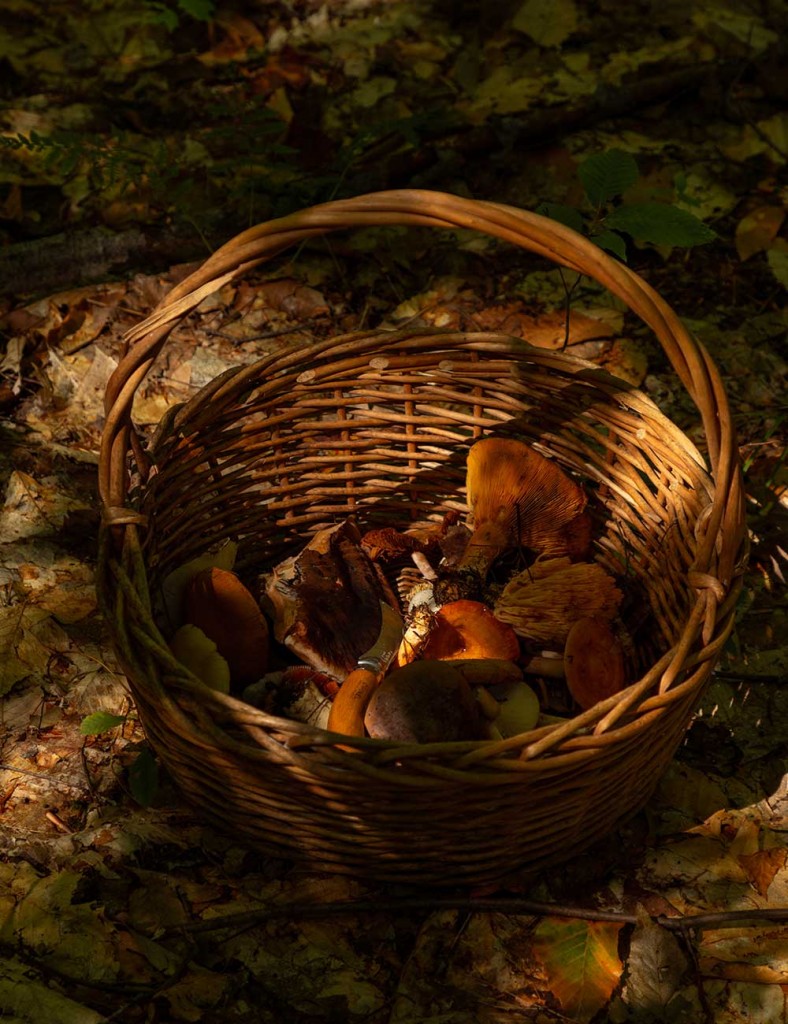
The Ethical Mushroomer’s Code
Every club has a rulebook.
Leave The Woods Better Than How You Found Them
Watch where you step and tread lightly to avoid damaging plants, mushrooms, and living creatures. If you’re bringing a canine companion, don’t leave their droppings behind—the nitrogen in dog poop can imbalance and pollute soil. Pack a pair of protective gloves or a trash grabber along with a garbage bag, and remove what trash you can.
Take Only What You Need, Where You’re Allowed
Some of the most identifiable features of a mushroom lie below ground, which is why many hunters pick mushrooms in order to identify them. But with mushrooming, a little can go a long way.
“We see a lot of people who are interested in foraging go out and stripmine the forest of everything they find,” says Liberty. “And that can have a damaging effect on the ecosystem as a whole.”
If you’re mushrooming in an area where you’re allowed to pick mushrooms , take as few specimens as possible and only from dead matter — stripping bark from trees or damaging living wood to pick mushrooms are big no-nos.
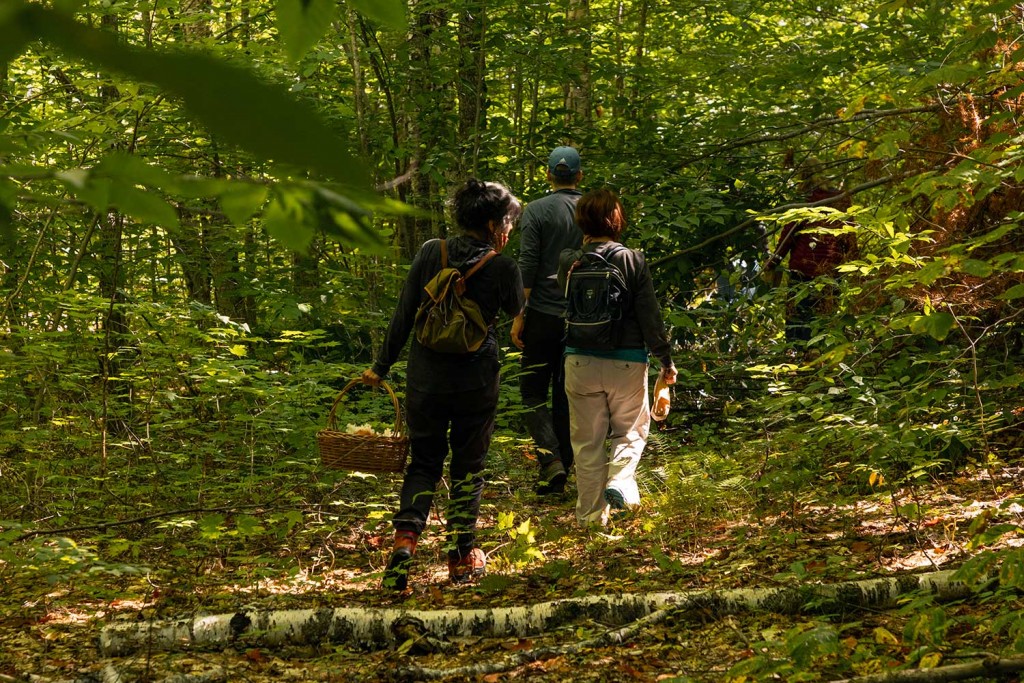
Don’t Eat Unverified Mushrooms
There are many poisonous mushrooms, and for beginners, it can be hard to tell the safe mushrooms from the dangerous ones. In urban environments, pollution, industrial runoff, and chemical fertilizers add another layer of risk to consuming mushrooms. Don’t eat mushrooms from urban parks and never attempt to eat a wild mushroom without having an expert verify its identity first.
Expert Tip: Keen to try foraging wild mushrooms in rural areas? Enrol in an expert-run introductory foraging course like those that Poitras teaches through her program, Connais ton Bolet.

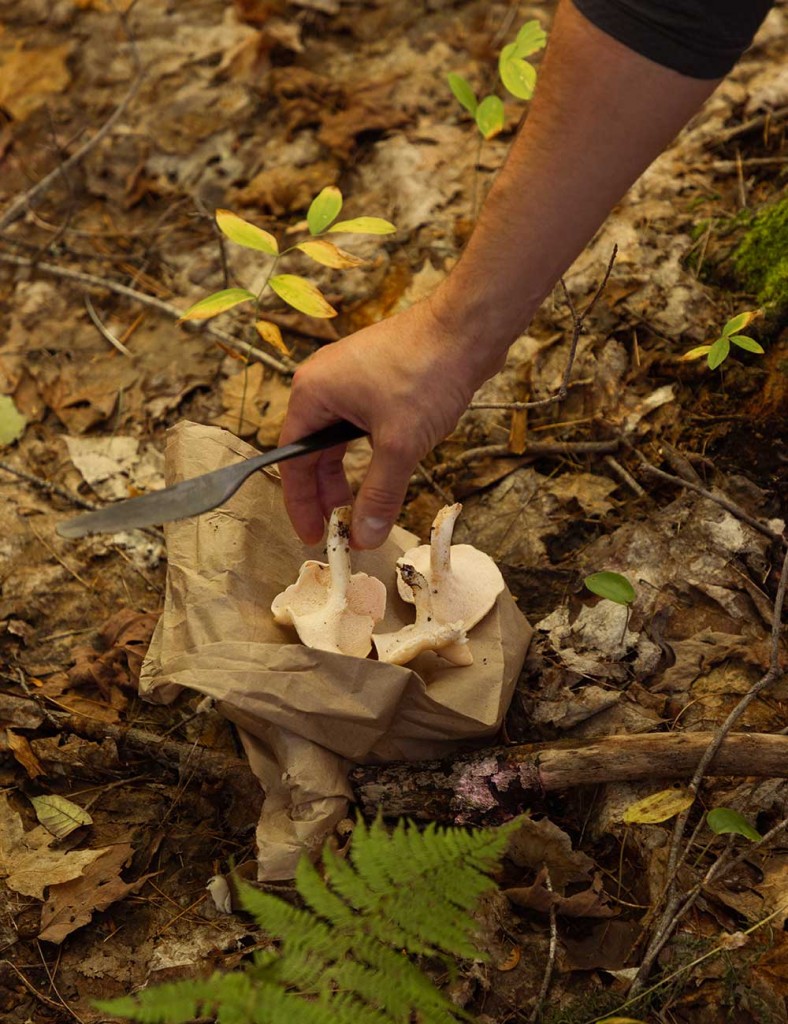
How to Get Started
Pick a park or forest
If you’re in the city, pick a park that’s at least a few generations old with ungroomed, mixed forest that contains both coniferous and deciduous trees. Toronto’s Rouge Park, Montreal’s Parc Angrignon, and New York’s Van Cortlandt Park in the Bronx offer some of the best urban mushrooming around. Whatever forest you find yourself in, look for moist soil and a decent amount of leaf litter and decomposing matter.
Follow the rules
You don’t have to pick mushrooms to go mushrooming—in fact, Toronto and Montreal have bylaws that prohibit the removal of mushrooms from city parks. Parks Canada has a similar policy that forbids the harvesting of fungi from provincial and national parks. Crown land is fair game for picking. Remember that to search on private land, you should ask for permission ahead of time.

Pack Your mushroom bag and knife
Mushrooms love the moisture that a good rain brings, so prepare for muddy conditions and layer up. Bringing bug spray and wearing long sleeves, long pants, high socks, and hiking boots can keep you comfortable and prevent unwanted run-ins with ticks. Have you made your way out of the city and you’re keen (and allowed) to pick mushrooms? You’ll want to pack a knife for extracting them, an open-air carrying basket, paper identification slips, and a pen.
Pack a magnifying glass and a camera or smartphone, ideally one with macro capabilities. Forests are low-light environments, so extra lighting can come in handy. That being said, you don’t need fancy camera lights to get great photos. If you have a ring light—one that emits warm, natural-looking light—it will do the job just fine. If you want to log your findings, remember to pack a field notebook.
Expert Tip: Store your samples in a carrying basket with dividers for the walk, then in a paper (never plastic) bag on the way home. Plastic makes mushrooms sweat, leaving the picker to clean up a wet, stinky mushroom mess.
Look down, but also up
Unlike plants, fungi can’t make their own food. Some break down dead plant matter to survive, others feed off living organisms as parasites, and some form mutually beneficial (mycorrhizal) partnerships with trees. To find fungi, plan to hunt down their food first. Scan the ground for piles of dead leaves and old tree trunks. Look up, too. Mushrooms like chaga grow on trees, often above eye level.
Expert Tip: Keep an eye out for rotting logs—”they’re like the coral heads of the forest,” says Liberty—and examine their ends and undersides for fungi.

Log your findings
Take notes and pictures of the area where you found the mushroom and nearby plants and trees. Then, hone in on the mushroom. Pay attention to the colour, shape, size and pattern of the mushroom’s distinguishing above-ground features, namely the cap and stem.
Does the underside of the cap have gills, pores, or teeth? Does the mushroom have a skirt enveloping part of its stem? Is its stem thick, thin, or even visible? If the mushroom has been removed from the ground, does it have a tap root or an egg-shaped base?
While it’s tough to precisely identify a mushroom without harvesting it, these observations can help you narrow down the mushroom group you’ve stumbled upon. Liberty and Sadowski recommend recording your observations in a field notebook.
Expert Tip: Need help getting a basic ID on a specimen? Take a pass on identification apps, which seldom work for identifying mushrooms. Instead, share your observations with your local mycological society or on Mushroom Observer, a website where experts help novices identify mushrooms that they aren’t familiar with.
“You want to get close up shots,” says Sadowski. “Look at the gills, the stem, and try to get as complete of a documentation pictorially to inform your post.”
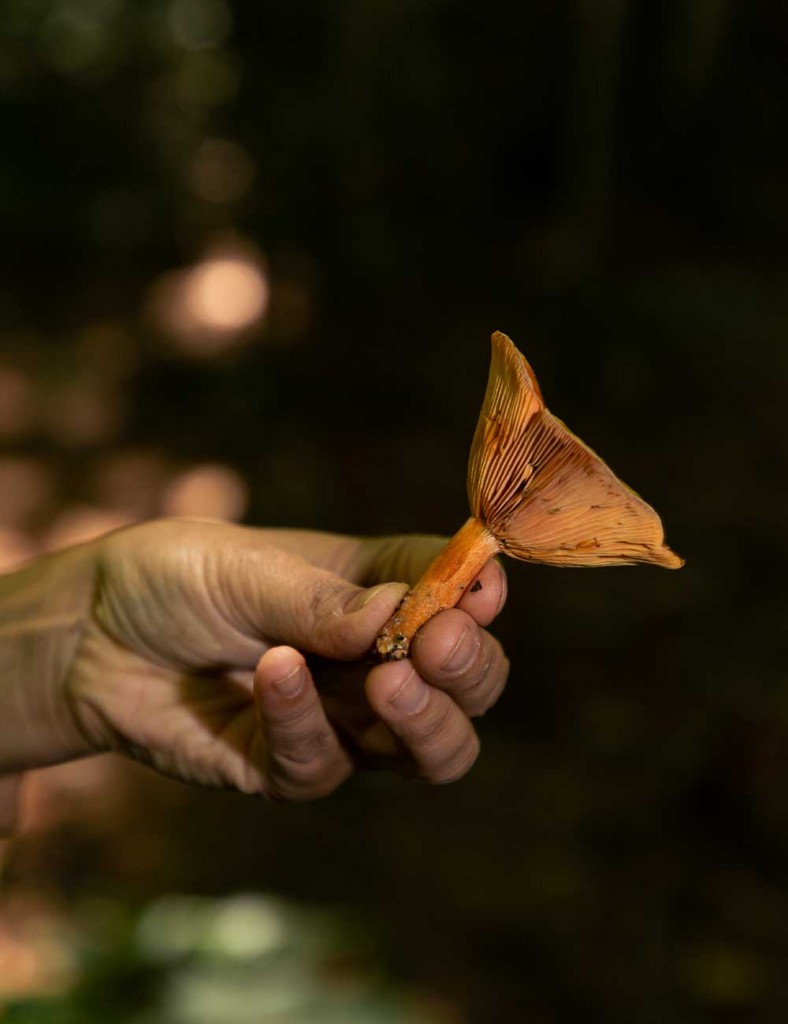
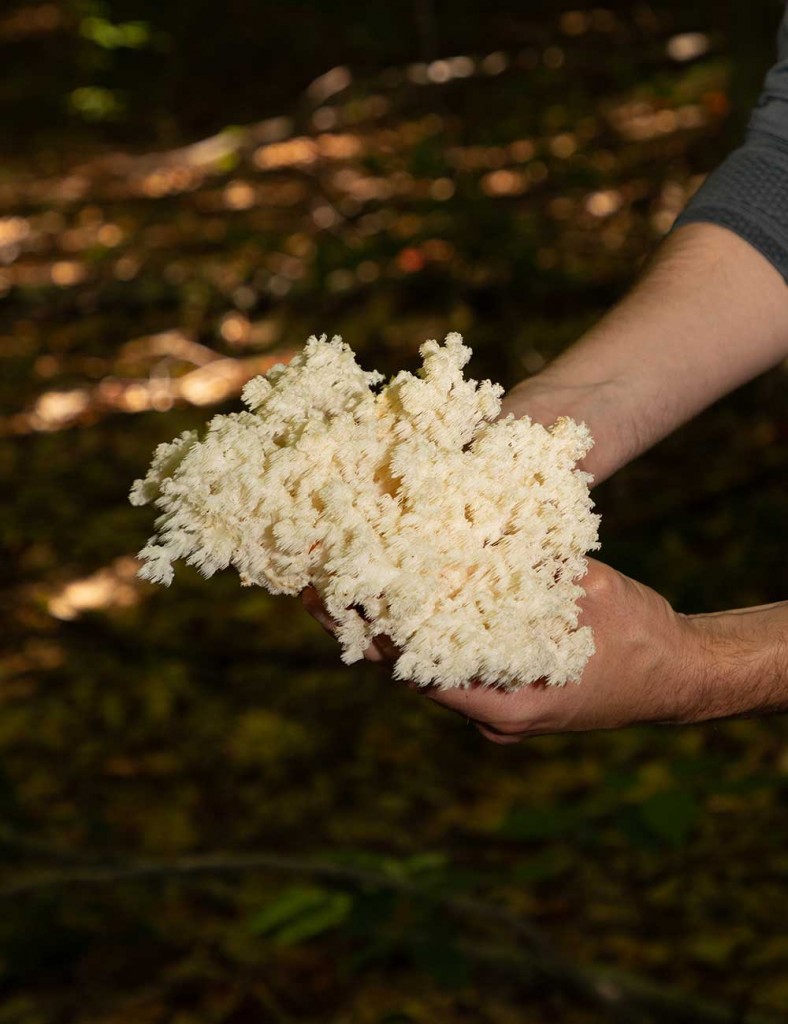
Three Mushrooms To Look For This Fall
Small saffron milk cap (Lactarius thyinos)
These orange mushrooms grow near coniferous trees, especially cedar. Other types of saffron milk caps will turn green when touched, but these ones keep their beautiful colour even when handled. They are edible, but as always, don’t partake until an expert has verified the ID.
Coral tooth fungus (Hericium coralloides)
Resembling a miniature, icicle-ridden tree, coral tooth fungus lacks an obvious stem but grows from a wood-attached core that produces intricate white branches with fleshy spines. It’s a saprotroph, meaning it feeds on nonliving organic matter, so check dead hardwood trees and stumps for this fungus.
Chanterelle waxy cap (Hygrocybe cantharellus)
These yellow-to-orange mushrooms are common to eastern North America and have trademark long, red-orange stems, sharp-edged gills, and slightly scaly convex caps. Look for them under hardwoods — Chanterelle waxy caps can also grow on decaying wood.

Classic Mycological Pairings
Know your spruces from your birches? Find the trees first, then look for the mushrooms. Mycorrhizal mushrooms prefer to form relationships with certain tree species or types:
- Ash boletes and ash trees
- Weeping boletes and coniferous trees, particularly pine and spruce
- Slippery jack mushrooms and pine trees
- Porcinis and spruce trees
- Fly agaric and birches, pines, and spruces
Want to hone your fungi identification skills?
Many cities have mycological societies that offer introductory courses on identifying and finding local mushrooms. Signing up for a mushroom foray with your local club can help you establish and sharpen your fungi identification skills.
“There are always people out there who know more than you do […] and who can help reassure and guide you,” says Poitras. “And it’s helpful, because often, you need to see a mushroom five or ten times in order to recognize it.”
Go deeper with BESIDE’s recommended reading list:
Mushrooms of the Northeastern United States and Eastern Canada by Timothy Baroni
Mushrooms of Ontario and Eastern Canada by George L. Barron
Jade Prévost-Manuel is a Canadian journalist who has reported for publications like SUSTAIN Magazine, Outpost Magazine, and CBC News. When she’s not telling stories on land, she’s exploring life below the ocean’s surface.
Never Miss Another Issue
Two issues per year
25% OFF previous issues
Free Shipping in Canada